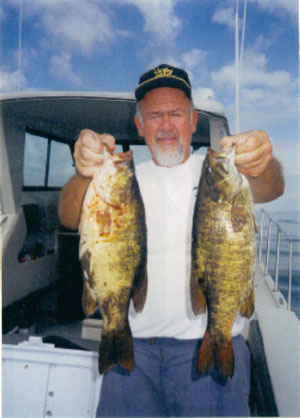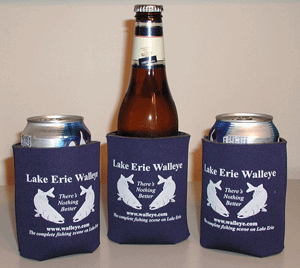|
Super
Summer Smallmouth
By Capt. Phil Cadez
Many articles have been written on the
great walleye fishing the past few decades on Lake Erie.
More anglers are finding out how really great the smallmouth
fishing is in the Western Basin of this Great Lake. It’s always been
one of the top “jumper” areas in North America. It’s natural limestone
rocky islands and reefs hold millions of these hard fighting sport fish.
decades on Lake Erie.
More anglers are finding out how really great the smallmouth
fishing is in the Western Basin of this Great Lake. It’s always been
one of the top “jumper” areas in North America. It’s natural limestone
rocky islands and reefs hold millions of these hard fighting sport fish.
The smallies
are fat and sassy and will challenge your fishing abilities. The “bronzeback”
population sustains itself because the lake is so clean and loaded with
food fish. Their
favorite diet consists of emerald shiners, shad and crayfish, but
gobi’s are so
plentiful the bas are gorging themselves and growing very hefty. It’s
hard to believe there’s so many smallmouth bass over 5 pounds in the
lake.
Smallmouth are
not a roving fish as are walleye or steelhead. Most grow up and stay
within a quarter mile or less the rest of there existence.
Walleyes have been know to move miles
in a day or so. A
smallmouth is a territorial fish and will school in summer not moving
much if they have food fish readily available. The best time to fish
for these “bronze brutes” is July thru October.
They’re eating machines and can be caught all day even in hot sun
shining days. Only a major weather front will shut them down for
awhile.
A good fish locator will help you find the
hard bottom structure that will insure good fishing for these tough
fighters. Start in 12
feet of water looking for drop offs that are near that might go down to
20 or even 30 feet.
The rougher the structure the better.
The fish will move to different depths because of water currents,
food fish, rough water, high sunlight etc.
They’ll be somewhere near the drop offs keep looking.
One day they’ll be on
the down side of the humps next day they might be on the up side of this
structure.
Once you have found the right areas to
start fishing you can fish with artificial jigs, tubes, power grubs
etc., or live bait. In a
light chop you can drift over the structure bouncing the bottom with
jigs or especially tube jigs.
You might want to use at least 3/8 to 5/8 ounce jigs if you have
to get down to lower depths. Use only jig heads that allow you to place
the plastic bodies or tubes the right way. They will be completely
inbeded in the tubes with only the hook
exposed. Tubes can be
plain or have a salty flavor and be 3 or 4 inches in length. Favorite
colors are pumpkin seed, plum, watermelon,
chartreuse, silver speckled or other combinations of these
colors.
You need to be near the bottom so let the
jig get down in the rocks. Pop it with a jumping motion,
then let it settle back down.
While letting it settle don’t leave much slack because the fish
might hit it on the drop.
You’ve got to set the hook hard if you feel a bump.
Live bait fished near the bottom is
probably the easiest and best way to catch these bronze brutes. The
tackle used consists of light spinning or bait casting combinations,
rods are usually short but firm, 5 to 5-1/2 feet in length with graphite
composition. You can use
a swivel on a 24 inch leader with a hook. Either way you hook up this
rig it will keep the slip sinker away from the bait.
A number 24 or 26 center drought Mustad
hook tied securely to the end of the line is the most preferred rig.
If the wind is slight, and the drift is
slow you can locate the right depth by dragging soft craws or leeches
near the bottom. If the
drift speeds up use heavier slip sinkers.
Some anglers have the bait set and set the hook early while
others open the bail and let the fish go with the bait.
Either method works providing the fish has the bait securely in
it’s mouth.
When you’re sure the fish has the bait,
set the hook and hold on. Softcraws are the
best bait and are sold in local bait shops for approx. $5.00 per dozen.
Make sure you have at least 3 to 5 dozen per person, because
sheepshead
also love these tasty bait.
Hook the crawfish by the tail and try to keep it close to the
bottom.
If you have located the fish near some
structure you might make it with a buoy so you can keep drifting by it
or you can anchor on or near the “honey hole”. Anchor with a long line
so that you can change position without starting the motor by taking in
or letting out more anchor line.
When anchored, drop the crawfish to the bottom but keep the
sinker 6 to 12 inches off the structure.
Again, you can set the hook early or better yet let the fish run
with the bait. Set your drags easy or you’ll break the line with the
tension of these fishing bronzebacks.
Keep moving till you start catching
mostly jumpers. You
might have to move many times to find the right position. When you find
it you’ll know in a hurry. I’ve seen lines in the water with five fish
on at a time. I’ve put
three fish in the net at the same time.
Experienced anglers that have visited
Lake Erie’s super smallmouth areas agree that it’s one of the best areas
in North America to get a trophy over 5 pounds. We average 14 to 23
inch fish which goes 2 to 6 pounds.
The Ohio record is over 9 pounds caught near
Kelley’s Island. Please practice catch and release to insure great
future fishing.
If you want to get in on this super
fishing, bring a good size boat or book a charter with
a experienced guide. You can reach me thru
my web page at
www.cadez-charters.com. |





 decades on
decades on